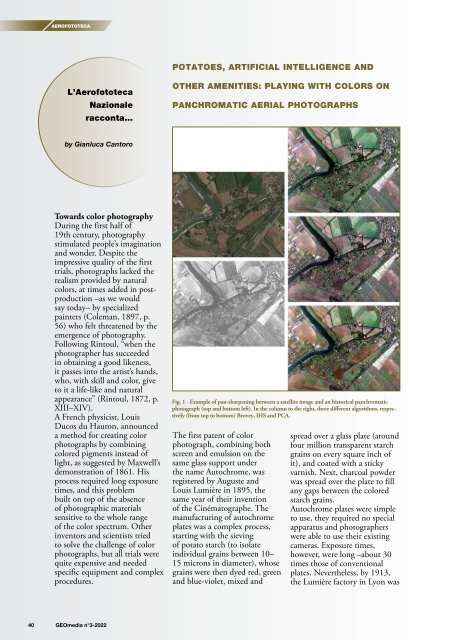You also want an ePaper? Increase the reach of your titles
YUMPU automatically turns print PDFs into web optimized ePapers that Google loves.
AEROFOTOTECA<br />
POTATOES, ARTIFICIAL INTELLIGENCE AND<br />
L’Aerofototeca<br />
Nazionale<br />
racconta…<br />
OTHER AMENITIES: PLAYING WITH COLORS ON<br />
PANCHROMATIC AERIAL PHOTOGRAPHS<br />
by Gianluca Cantoro<br />
Towards color photography<br />
During the first half of<br />
19th century, photography<br />
stimulated people’s imagination<br />
and wonder. Despite the<br />
impressive quality of the first<br />
trials, photographs lacked the<br />
realism provided by natural<br />
colors, at times added in postproduction<br />
–as we would<br />
say today– by specialized<br />
painters (Coleman, 1897, p.<br />
56) who felt threatened by the<br />
emergence of photography.<br />
Following Rintoul, “when the<br />
photographer has succeeded<br />
in obtaining a good likeness,<br />
it passes into the artist’s hands,<br />
who, with skill and color, give<br />
to it a life-like and natural<br />
appearance” (Rintoul, 1872, p.<br />
XIII–XIV).<br />
A French physicist, Louis<br />
Ducos du Hauron, announced<br />
a method for creating color<br />
photographs by combining<br />
colored pigments instead of<br />
light, as suggested by Maxwell’s<br />
demonstration of 1861. His<br />
process required long exposure<br />
times, and this problem<br />
built on top of the absence<br />
of photographic materials<br />
sensitive to the whole range<br />
of the color spectrum. Other<br />
inventors and scientists tried<br />
to solve the challenge of color<br />
photographs, but all trials were<br />
quite expensive and needed<br />
specific equipment and complex<br />
procedures.<br />
Fig. 1 - Example of pan-sharpening between a satellite image and an historical panchromatic<br />
photograph (top and bottom left). In the column to the right, three different algorithms, respectively<br />
(from top to bottom) Brovey, IHS and PCA.<br />
The first patent of color<br />
photograph, combining both<br />
screen and emulsion on the<br />
same glass support under<br />
the name Autochrome, was<br />
registered by Auguste and<br />
Louis Lumière in 1895, the<br />
same year of their invention<br />
of the Cinématographe. The<br />
manufacturing of autochrome<br />
plates was a complex process,<br />
starting with the sieving<br />
of potato starch (to isolate<br />
individual grains between 10–<br />
15 microns in diameter), whose<br />
grains were then dyed red, green<br />
and blue-violet, mixed and<br />
spread over a glass plate (around<br />
four million transparent starch<br />
grains on every square inch of<br />
it), and coated with a sticky<br />
varnish. Next, charcoal powder<br />
was spread over the plate to fill<br />
any gaps between the colored<br />
starch grains.<br />
Autochrome plates were simple<br />
to use, they required no special<br />
apparatus and photographers<br />
were able to use their existing<br />
cameras. Exposure times,<br />
however, were long –about 30<br />
times those of conventional<br />
plates. Nevertheless, by 1913,<br />
the Lumière factory in Lyon was<br />
40 <strong>GEOmedia</strong> n°3-<strong>2022</strong>


















